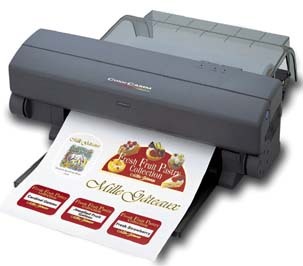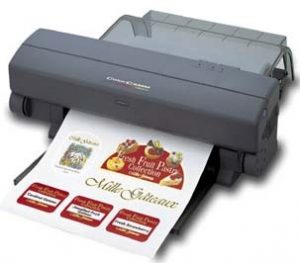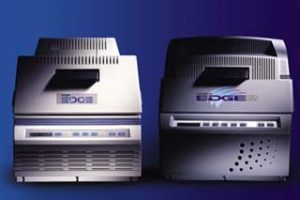Digital Printing
Digital Printing: Good or Bad Times Ahead?
Emerson, Sean and Darek talk about digital futures
Published
18 years agoon

Last week, I talked with Sean O Leary and Emerson Schwartz-kopf [two of the foremost digital-signmaking experts] about digital-print machines, plus the environment and economy that encompass them. I wasn t interested in facts as much as I was the constitutive background of the digital-print industry. My curiosity was piqued after reading an article Emerson published in Britain, in which he asked if large-format digital printing is waning.
Emerson answered by saying the digital-print industry s future lies in its technological penetration into various markets, and learned manufacturers are targeting their products for specific needs. More than ever, he says, End use is a critical factor in designing machines.
You might ask what determines this critical, end-use factor and who, in the wide circle of digital-machine manufacturing and marketing executives, chooses what machine type, or machine improvement, to pursue next?
I can tell you. It s the digital-print-machine manufacturing company s CEO.
Although a boxcar load of information details the craft of digital printing and its possible markets, rarely examined is the health of the industry as seen from the CEO s viewpoint. Meaning, how does he or she see the company s future and where does he or she plan to go with it?
Two firm indicators mold their viewpoints: the CEO s present attitude towards research and development, and regulation of the company s marketing budget. If these two budgets decline simultaneously, the CEO has surely lost interest. If this incident occurs with several manufacturers, the total industry declines. And, because of current economics and doubts spawned by Enron, World.com, etc., I think digital signmakers — or those who want to become digital signmakers — should know the industry s pulse as reflected by these executives.
AdvertisementAs trade journalists, we learn of such trends by developing trust with industry executives, talking with them and keeping their confidences. These relationships don t preclude us offering our own viewpoints and opinions, however. To crystallize our current thinking, I ve assembled seven questions for Sean, Emerson and me to answer.
Do you think the digital print industry — as it relates to signmakers – is going away, in a slump or soaring?
Sean: Isn t there a category for steady growth? I think there s steady growth.
Emerson: I think it s static. Customers aren t ordering less, but they re not expanding their budgets and tripling their orders yet. As the economy — and the way people think about the economy — improves, we ll see more money go into marketing. Identity signage, POP and out-of-home are cheap and efficient ways of getting the message across by any means of production, and digital printing gives an additional advantage.
Darek: I agree with Sean s comment on steady growth — if the economy remains reasonably stable. Digital printers are practical tools, and a signmaker ignoring digital printing is like a carpenter ignoring a nail gun (no self-respecting carpenter is without a nail gun). In the digital-sign-printing field, new products (faster, easier to operate, with better print quality and extended, outdoor-durable inks) will certainly cause existing digital-sign printers to upgrade their equipment. Alongside this are startups, those shops — or entrepreneurs — new to digital-sign printing who want to find a way in.
Do you think the digital-print-machine manufacturing companies are increasing or decreasing their R&D efforts?
AdvertisementSean: I think the category is too broad to answer this question realistically.
Emerson: They re spending more if you compare ratios of R&D to sales. Of course, most companies also have flat or declining sales right now. Most will continue to increase R&D, because it s an improve-or-die situation with digital printing right now. Making significant cuts means that you can t see a need to develop a new product or significantly change what you ve got, and that s the wrong message to send to any potential buyer.
Darek: Lately, I ve been asking digital-print-machine and software-manufacturing executives if they are increasing or decreasing their R&D budgets. In every case, the answer was increasing.
You ll want to swallow this information with salt, however, because those higher R&D monies may or may not be directed at signmakers. They may be directed at altering or improving existing products for sale outside the sign industry. The recent trend of developing higher DPI counts is an example. You sometimes need ultra-high DPI for signs and posters, but it s even better suited for printing art and photography.
Do you see print-machine-manufacturing companies increasing or decreasing their marketing budgets?
Sean: I think they re trying to get as much mileage out of PR as they can. I don t see a trend in advertising.
AdvertisementEmerson: Marketing will increase with new products, or if companies see an ailing competitor and smell blood. Don t be surprised to see marketing efforts designed to kill a competitor, because a flagging economy is the right time to force some consolidation. Otherwise, the idea of the generic our products are great image ad is probably dead right now in digital printing, unless it s from a large corporation that can t figure out how to market to small, targeted groups like signmakers.
Darek: Again, in my casual interviews, digital executives said they were increasing the marketing budgets, although one in particular, after saying, We are increasing our budgets but looking closer at how we spend it, actually cut back on its advertising program.
What do you see digital-print buyers wanting?
Sean: Lower prices and faster turnaround — the same thing they always wanted. I doubt if they would describe themselves as digital-print buyers, because I doubt if they care how it s produced. They are still just graphics customers.
Emerson: For signmakers, it s simple. To build signs, they need a printer that prints, with minimum hassle, images that can be installed easily and are ready to go right from the printer. And, of course, get the sizes as close to a 4 x 8 ft. as possible, with scratch-durability and less than 80% fade after three years outdoors. This hasn t changed since digital made its first big splash at the 1993 NESA show in Las Vegas.
Darek: Pizazz, price, profit and on-time delivery. Most of all, it s giving them an image with what they consider as pizazz, at a fair price so they can make a profit. The greatest weakness I see is that digital-print-machine owners aren t aggressively marketing their local business communities. Signmakers must see themselves as visual communications, advertising and problem-solving companies. They need to be close to their customers.
Where can signmakers find new digital-print business?
Sean: The banner-stand and portable-display business is continuing its growth trend. The only other area is consumer/pro-sumer, where there is a high risk-to-reward ratio. It s been a question mark for five years. But if Kinko s is making a public commitment to this niche, chances are there s plenty of untapped business.
Emerson: New products sell if old customers buy. Everyone tries to find the magic cure of those new markets where all untapped dollars will suddenly flow like rivers of gold. They don t exist. Current customers can tell you what they need and what you re not giving them. You have to ask.
It s also worth looking into the world of co-op advertising. There are literally billions of dollars out there being spent by large corporations to help retailers and wholesalers advertise their products. It s a cinch that some of that can be diverted to signage and POP, but it s going to take some digging — and help from your customers — to find areas where someone else can pay part of the bill.
Darek: I m partial to Emerson s answer to, Do you want to Super Size® that? He s saying to ask present customers for more business. Similarly, I ve seen Butch Super Frog Anton encourage this practice at his tradeshow seminars. He says to show (read sell ) your sign buyers color and raise the overall value of the sale. Another sales coach said to ask a customer if static products in the store that are difficult to sell — such as old movies at a video store — then suggest a digital-sign program that would help. This program could include Sean s portable-display suggestions.
Five years from now, how do you see digital-signmaking/printing machines changing?
Sean: Flatbeds will probably come down in price to the point where they penetrate mainstream signmaking.
Emerson: Signprinting, like vinyl cutting today, will be a total commodity item. For the majority of shops, it ll be like the cutter, computer and cell phone. It s a tool. It d be nice to think that we could have something along the lines of Star Trek, where, in 2007, you d turn to the machine and yell, Governor, California, truck, and get a large graphic of Arnold Schwarzenegger in two minutes, but the printer will likely be something that produces good, outdoor-durable graphics in a reasonable time.
Darek: I see more flatbed printers, but faster printers that are easier to operate. To this, add a higher selection of durable inks that, hopefully, will either print on various substrates or, with an odd-gun printhead, spray a coating on a substrate so it will accept the ink. I also expect to see more outsourcing to the superlarge-format printmakers, and networking between smaller shops that operate different machines.
Finally, if you were in the digital signmaking business, what would you do to put yourself above your competitors?
Sean: Upgrade my showroom/ waiting-room presentations. Amazing how many companies ignore the POP and impulse-buy potential of these areas.
Emerson: If you have digital, sell digital. If it increases turnaround time, do jobs quicker. If you can slice a nickel on price here and there, do it. If you can do custom jobs, push them and charge a bit extra.
Digital also gives you more opportunities to upgrade a customer. Ask if they d like it bigger, or if they need a frame or lightbox with that flexible graphic, or if they d like to change the graphics on a regular basis. It never hurts to ask or supply other options that digital production creates or enhances. If McDonald s can teach teenagers to always say seven words – Do you want to Super Size® that? — and add a couple billion in sales per year, signmakers should be able to use digital to coax a few more dollars out of clients.
Darek: Hire and train good staff, assign them definite responsibilities and pay monthly profitsharing. Once done, I would get out of the shop and aggressively work to create relationships within the business community. $image2
Our conclusions are to expect change — but not radical change — and that the industry and its leaders are sound. I would add that, if you re a small shop owner hesitant to make a major purchase, you should examine entry-level inkjet or thermal-transfer equipment.
I concede, however, that I ve found entry level to be an elusive term. I think it s fair to expect an entry-level purchase to include digital printer with minimum operating complexity and steadfast quality at a low price. Further, I think an entry-level digital-print machine should ship as a complete — ready-to-print — package, including start-up supplies. Plug and play, so to speak.
If you re entering the POP and display fields, a medium-level poster and display-making inkjet is an entry-level machine. Here are some examples: Oce s six-color Arizona 30 digital printer; Epson s 44-in.-wide 9000; HP s 24-in.-wide 430; Encad s NovaJet 500; Mutoh s Falcon and Toucan; several from Roland DGA Corporation s SolJet series.Hewlett-Packard Roland DGA Corporation, Oce, Mutoh
Perhaps the only true entry-level digital printer for signmakers that meets the three requirements of ease of use, low price ($4,995) and quality manufacturing is Roland s ColorCAMM PC-12 desktop thermal transfer printer/cutter. Using either wax or resin ribbons, it produces
six-color, 1,200-dpi digital prints (water-, scratch- and UV-resistant without lamination) and contour cuts them. These features make it quite suitable for short-run decals, labels, signage and vehicle graphics. Following this would be the Gerber Edge® and Summa s thermal-transfer SummaChrome and DuraChrome.
SPONSORED VIDEO
Introducing the Sign Industry Podcast
The Sign Industry Podcast is a platform for every sign person out there — from the old-timers who bent neon and hand-lettered boats to those venturing into new technologies — we want to get their stories out for everyone to hear. Come join us and listen to stories, learn tricks or techniques, and get insights of what’s to come. We are the world’s second oldest profession. The folks who started the world’s oldest profession needed a sign.
You may like
Advertisement
Subscribe

Magazine
Get the most important news
and business ideas from Signsofthetimes Magazine.
Advertisement
Most Popular
-

 Tip Sheet1 week ago
Tip Sheet1 week agoAlways Brand Yourself and Wear Fewer Hats — Two of April’s Sign Tips
-

 Photo Gallery3 days ago
Photo Gallery3 days ago30 Snapshots of the 2024 ISA Sign Expo
-

 Ask Signs of the Times4 days ago
Ask Signs of the Times4 days agoWhy Are Signs from Canva so Overloaded and Similar?
-

 Real Deal2 weeks ago
Real Deal2 weeks agoA Woman Sign Company Owner Confronts a Sexist Wholesaler
-

 Benchmarks1 week ago
Benchmarks1 week ago6 Sports Venue Signs Deserving a Standing Ovation
-

 Women in Signs2 weeks ago
Women in Signs2 weeks ago2024 Women in Signs: Megan Bradley
-

 Photo Gallery1 week ago
Photo Gallery1 week ago21 Larry Albright Plasma Globes, Crackle Tubes and More
-

 Women in Signs1 week ago
Women in Signs1 week ago2024 Women in Signs: Ashley Borell












